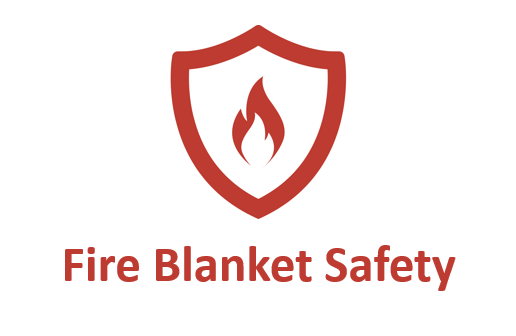
Let’s say you're in the kitchen, cooking up a storm, and suddenly, a small grease fire erupts on the stove. Panic sets in, but then you remember you have a kitchen fire blanket tucked away in a nearby cabinet. You grab it, throw it over the flames, and just like that, the fire is out.
Well, that's the magic of fire blankets! They're like superheroes in the world of fire safety, quietly waiting for their moment to swoop in and save the day. But have you ever wondered what these life-saving blankets are made of? That's what we're here to explore.
We'll take a journey into the world of fire blankets, uncovering the secrets behind their construction, the materials that make them tick, and why they're so darn effective at what they do. Ready? Let's go!
What is a Fire Blanket: The Historical Journey
To truly understand the evolution of fire blankets, we must first rewind the clock and delve into the annals of history where the seeds of this essential fire safety tool were first sown. Ancient Greeks and Romans would often saturate woolen clothes in water to create makeshift fire barriers during firefighting efforts. Similarly, in middle age, thick woolen blankets or rugs were employed to suffocate flames and protect against the spread of fire in homes and workshops.
The 19th century witnessed a surge in the production of fire-resistant fabrics, thanks to innovations such as asbestos-based textiles and treated wool materials. These new materials offered superior heat resistance and durability, making them ideal candidates for use in fire blankets.
One notable milestone in the history of fire blankets occurred in the early 20th century with the invention of the iconic "fire curtain" by British engineer James Braidwood. These heavy woolen curtains, treated with fire-retardant chemicals, were designed to be unfurled in theaters and public buildings during fires, effectively containing flames and preventing their spread to adjacent areas.
The mid-20th century saw further advancements in fire blanket technology. Fiberglass, a lightweight and highly heat-resistant material, offered superior fire suppression capabilities compared to their woolen counterparts, thanks to their ability to withstand higher temperatures and resist degradation.
Today, modern fire blankets are crafted from a variety of advanced materials, including fiberglass, silica, and aramid fibers, each chosen for its unique combination of heat resistance, durability, and insulating properties. The evolution of fire blankets, from humble beginnings as simple woolen cloths to the sophisticated, high-performance safety devices of today, fire blankets have undergone a remarkable transformation, playing a vital role in protecting lives and property against the destructive force of fire. Let's delve into the components of fire blankets and explore how each material contributes to their effectiveness.
Unveiling the Layers: The Essential Materials Used in Fire Blanket
Fire blankets are composed of a carefully selected combination of specialized materials, each chosen for its unique properties and contributions to fire suppression and safety. These materials work together to create a durable and effective barrier against flames, heat, and smoke.
1. Outer Layer
The outer layer of a fire blanket is typically made from heat-resistant materials such as fiberglass, silica, or aramid fibers.
Fiberglass: This lightweight and durable material is commonly used in fire blankets due to its excellent heat resistance and ability to withstand high temperatures without igniting or melting.
Silica: Silica fabrics offer exceptional heat resistance and are often used in industrial-grade fire blankets designed for high-temperature applications.
Aramid Fibers (e.g., Nomex or Kevlar): These synthetic fibers provide excellent flame resistance and strength, making them ideal for use in fire blankets intended for rugged environments or special firefighting tasks.
2. Inner Insulating Layer
Beneath the outer layer lies the inner insulating layer, which is designed to smother flames and dissipate heat to protect individuals or objects covered by the blanket. Common insulating materials include fiberglass, wool, and ceramic fibers.
Fiberglass: In addition to its role in the outer layer, fiberglass can also be used as an insulating material due to its ability to resist heat transfer and provide thermal insulation.
Wool: Natural wool fibers have inherent flame-retardant properties and can absorb moisture, making them effective at extinguishing small fires and providing thermal protection.
Ceramic Fibers: These lightweight and heat-resistant fibers offer excellent thermal insulation and are often used in fire blankets designed for extreme heat exposure.
3. Binding Material
The edges of a fire blanket are typically bound with a heat-resistant binding material to reinforce the blanket's structure and prevent fraying.
Common binding materials include heat-resistant threads made from materials like fiberglass or aramid fibers. These threads are selected for their ability to withstand high temperatures and maintain the integrity of the blanket's edges under fire conditions.
By understanding the role of each material in the construction of fire blankets, we gain insight into their effectiveness as essential tools in fire safety and emergency response efforts.
Crafting Safety: A Detailed Look at the Manufacturing Process of Fire Blankets
The manufacturing process of fire blankets involves several intricate steps that ensure the final product meets safety standards and provides effective protection against flames and heat. Let's delve into each stage of the manufacturing process in detail:
1. Material Selection
The first step in manufacturing fire blankets is selecting the appropriate materials. These typically include heat-resistant outer layers (such as fiberglass, silica, or aramid fibers), insulating materials (such as fiberglass, wool, or ceramic fibers), and heat-resistant binding materials (such as fiberglass or aramid threads).
Each material is chosen for its specific properties, including heat resistance, durability, and flame-retardant characteristics.
2. Cutting and Preparation
Once the materials are selected, they are cut to the appropriate size based on the desired dimensions of the fire blankets. The outer layers, inner insulating materials, and binding materials are prepared for assembly, ensuring uniformity and consistency in the final product.
3. Assembly
The assembly process begins by layering the outer heat-resistant material over the inner insulating material. The layers are carefully aligned and stitched together using heat-resistant threads to create a durable and secure structure.
Attention is paid to ensuring the edges of the fire blanket are reinforced with additional stitching to prevent fraying and maintain structural integrity.
3. Binding
Once the layers are stitched together, the edges of the fire blanket are bound using heat-resistant binding materials. The binding material is carefully sewn around the perimeter of the fire blanket, providing reinforcement and preventing unraveling.
4. Quality Control
Throughout the manufacturing process, strict quality control measures are implemented to ensure the final product meets safety standards and specifications. Fire blankets undergo rigorous testing to evaluate their flame resistance, heat insulation properties, and overall durability.
Any blankets that do not meet the required standards are rejected, ensuring only high-quality fire blankets are distributed to customers.
5. Packaging and Distribution
After passing quality control tests, the fire blankets are packaged according to industry standards and prepared for distribution.
By following these steps, manufacturers produce high-quality fire blankets that provide reliable protection against the dangers of fire.
Variations in Fire Blanket
Manufacturers offer a range of options to accommodate the varying requirements, resulting in several notable variations in fire blanket construction. Let's explore some of the key variations:
Industrial fire blankets are typically designed for heavy-duty applications in industrial settings, where they may be exposed to higher temperatures and more severe fire hazards. These blankets often feature multiple layers of heat-resistant materials, such as fiberglass or silica, combined with insulating materials like ceramic fibers to provide enhanced protection against intense heat. In contrast, household fire blankets are designed for use in residential settings and may feature lighter-weight materials while still offering effective flame resistance and heat insulation.
Some fire blankets are designed for specialized applications, such as welding or chemical fires, and are tailored to provide optimal protection in these specific environments. Welding blankets, for example, are constructed with materials that offer exceptional resistance to sparks, spatter, and molten metal, ensuring the safety of welders and surrounding equipment. Chemical-resistant fire blankets are equipped with materials that can withstand exposure to hazardous chemicals and acids, providing a protective barrier during chemical spill emergencies.
Thermal reflective fire blankets feature a metallic or aluminized outer layer that reflects heat radiation, reducing heat transfer and enhancing the blanket's effectiveness in containing fires and protecting individuals.
High-visibility fire blankets are equipped with reflective strips or bright colors to improve visibility in low-light conditions or emergency situations. These blankets are particularly useful in industrial environments or emergency response settings where visibility may be limited, ensuring quick and easy identification during deployment.
Key Takeaways
Fire blankets are indispensable tools in fire safety, providing swift and effective protection against flames and heat. As we reflect on the construction, materials, and environmental considerations of fire blankets, it becomes clear that their role extends beyond mere safety devices.
They represent a harmonious balance between safety, innovation, and environmental responsibility. By embracing sustainable practices and selecting eco-friendly materials, manufacturers and consumers can reduce the environmental impact of fire blankets while ensuring their continued effectiveness in fire safety protocols.
Frequently Asked Questions About What Are Fire Blankets Made Of?
1. What are the two types of fire blankets?
There are two types of fire blankets: woolen fire blankets and fiberglass fire blankets. Woolen fire blankets are made from natural wool fibers and are used in household settings. Fiberglass fire blankets are made from heat-resistant fiberglass materials and are used in industrial and commercial environments.
2. What is a fire blanket?
The inner layer of a fire blanket is made of materials such as fiberglass, wool, or ceramic fibers, which help smother flames and dissipate heat. The layers are stitched together with heat-resistant threads and bound along the edges to create a durable and effective barrier against fire.
3. What are old fire blankets made of?
In the past, fire blankets were commonly made of wool due to its natural flame-retardant properties and availability. Woolen fire blankets were effective in smothering small fires and providing thermal insulation.




